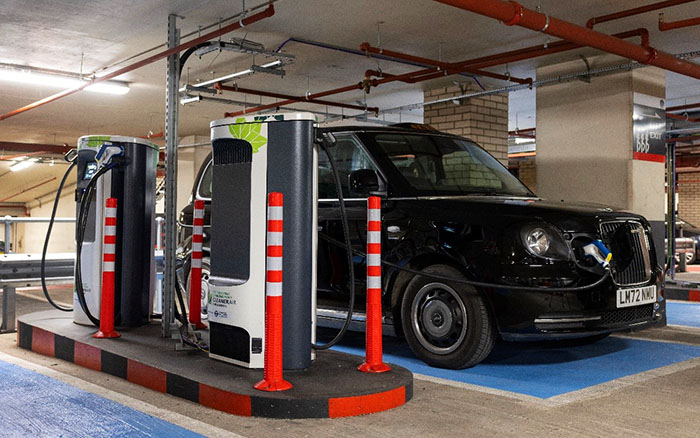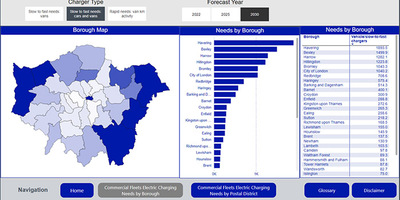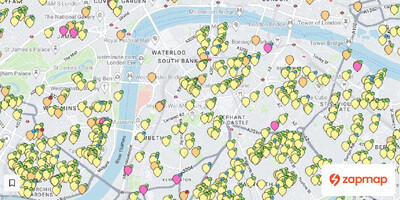Electric vehicles & charge points
We need to clean up London's air and rid the capital of the most polluting vehicles. The Mayor has an ambition for London to be a zero-carbon city by 2030 and to improve air quality as part of the Mayor's Transport Strategy.
To achieve this, we're supporting and accelerating the shift to zero emission technologies such as electric cars, led by an Electric vehicle (EV) infrastructure strategy.
We also need to reduce overall traffic and car ownership in London. Opting to join a car club (many of which are now electric) instead of privately owning a car will support this and result in a further reduction in air pollution. Find out more about car clubs.

Electric vehicles types
The main types of plug-in electric vehicles are:
- Battery electric vehicles (BEV) are powered by a battery which drives the electric motor. They have no exhaust or tailpipe emissions. Most new battery electric vehicles have a real- world range of 100 to 300miles on a single full charge
- Plug-in hybrid electric vehicles (PHEV) also have a conventional diesel or petrol engine, PHEVs have a fully electric range of up to 50 miles. They can also operate in hybrid mode, using the internal combustion engine
Benefits
By switching to an electric vehicle you can save money on fuel costs, reduce harmful vehicle emissions and help clean up London's air.
There are also financial benefits:
- Zero emission vehicles that meet the criteria are eligible for a 100% discount on the Congestion Charge until 24 December 2025
- The Government offers grants for some new plug-in vehicles. Find out about plug-in vehicle grants
- Electric vehicles currently pay either no vehicle tax (VED) or a reduced rate depending on their CO2 emissions, vehicle list price and year of registration. Find out about tax benefits
- There area range of incentives for business users
- Some London boroughs offer free or reduced-charge parking for electric vehicles
Charging your vehicle
Public charge points are available if you cannot charge your vehicle at home or at your workplace. The number of public charge points in London continues to increase.
Slow and fast public charge points are available on residential streets and at key destinations, including public car parks. The charging time will depend on the power level of the charge point and the capacity of your vehicle's battery.
Rapid and ultra-rapid charge points allow faster charging of your electric vehicle, taking as little as 20 minutes to get an 80% charge, depending on your vehicle's battery capacity. The cost per kilowatt hour (kWh) is higher with a faster charging speed.
If you are a Londoner who does not have access to off-street parking to charge at home, you can suggest a location for the delivery of an on-street, slow charge point through your borough. Find out how to suggest a location for a new charge point near to where you live.
Map of electric vehicle charge points
Charge point maps by Zap-Map show where charge points are located across London.
Zapmap also provide real time information showing charge point availability, price per kWh and route planning information as well as allowing drivers to filter for public charge points by power, connector types, networks and payment options.

London's 2030 electric vehicle (EV) infrastructure strategy
London's electric vehicle infrastructure strategy looks ahead to 2030, taking into account recent and expected future developments in the industry. It updates our understanding of typical user requirements as the transition to EVs accelerates beyond early adopters.
The strategy - published in December 2021 along with an executive summary - sets out what is needed to ensure enough EV infrastructure is in London by 2030, and proposes how we will work with the wider public sector and private sector to achieve this.
Electric vehicle infrastructure borough support pack
We have created an electric vehicle infrastructure support pack for borough officers to assist them with electric vehicle infrastructure strategy development and delivery of charge points.
Commercial fleets charging
We are working to support fleet and logistics operators on their way to meeting net zero carbon. We have created a commercial vehicle dashboard to show where there is a higher need for public charging points for vans in London. This dashboard includes a heatmap showing which areas will need more rapid, opportunity charging, as well as overnight, slow-to-fast charging for light commercial vehicles.

Commercial fleets dashboard
A dashboard to support the planning of infrastructure for vans in London
There are different resources aimed at supporting fleets in the electric transition. LoCITY is an industry-led programme to help the freight and fleet sector lead the way in improving air quality and reducing carbon emissions. The Freight Portal provides resources on HGV fleet decarbonisation and wider fleet support schemes.
Electric vehicle (EV) infrastructure delivery plan
The London electric vehicle infrastructure delivery plan published in 2019 shows fleets, businesses and London's residents that there is a clear way forward towards the right type and amount of charging infrastructure to serve London's needs. Its forecasts have since been updated in our new EV infrastructure strategy.
You can read about the progress made since the launch of the London electric vehicle infrastructure delivery plan in the One year on progress report.
Electric Vehicle Infrastructure Delivery Plan
London Electric Vehicle Infrastructure Delivery Plan One Year On
Charge point installation guidance
We have written guidance for borough officers and third-party organisations to help them with the installation of new EV charge points.





